India’s hopes of qualifying for the AFC Asian Cup came crashing down after a strong 43-minute start was undone by recurring defensive errors and missed chances, ending their campaign in disappointment

Margao, Goa, October 14, 2025 — India’s hopes of playing in the 2027 AFC Asian Cup were dashed after a hard-fought 1‑2 defeat to Singapore at home. What began as a hopeful campaign, featuring a spirited opening 43 minutes, unravelled due to recurring flaws—missed chances, defensive lapses, and inability to sustain momentum.
The loss on home soil sealed India’s elimination from the qualification race, bringing a disappointing end to a campaign that had flickers of promise but ultimately failed to deliver.
Match Recap: Highs, Turning Points, and Heartbreak AFC Asian Cup

Early Brilliance: India Take the Lead
From the kickoff, India showed urgency. The Blue Tigers pressed high, controlled possession, and looked to assert dominance. Their efforts paid off in the 14th minute, when Lallianzuala Chhangte unleashed a superb left‑footed strike from outside the box, curling into the top corner past the Singapore goalkeeper. The home crowd erupted; India were in front and looked set to build.
For much of the first half, India continued to dominate. Their wing play looked sharp, midfield combinations found space, and Singapore were often pinned back. It seemed like India might impose their will on the match.
But just before halftime, disaster struck. In the 44th minute, Singapore’s Song Ui‑young capitalized on a momentary defensive lapse inside the box and slotted home the equalizer. The timing of the goal, just before the break, shifted momentum.
Momentum Shift & Singapore’s Surge
After the interval, Singapore appeared more confident. They looked sharper, more composed, and optimistic. In the 58th minute, Song struck again—this time from a crisp move that split India’s defence and allowed him to finish with composure. Suddenly, India were behind.
India tried to respond: substitutions came in (Rahim Ali, Udanta Singh, Brandon Fernandes) to inject pace and creativity. But their efforts lacked cutting precision. Several chances were created, but none converted. In the dying minutes, Brandon Fernandes missed a gilt‑edged opportunity—after good work from Udanta, he struck off target with the goal at his mercy. The final whistle confirmed India’s exit.
The Numbers Tell the Tale
- Possession & Control: India held the lion’s share in the first 45, dictating play, pressing, and forcing Singapore into reactive positions.
- Missed Chances: India squandered multiple opportunities, especially in the second half when urgency was needed most.
- Defensive Fragility: The equalizer and the winner came off defensive mistakes—loss of concentration at critical moments.
- Qualification Reality: Even a win would not have guaranteed India’s passage. They came into the match with just two points from four matches; Singapore and Hong Kong already had eight points.
Thus, while the match loss sealed the exit, India’s fate had been teetering for some time. The home defeat was the final blow in a campaign plagued by inconsistency.
The Broader Campaign: Signs of Decline & Recurring Issues
This was not an isolated failure; rather, it was a culmination of deeper troubles emerging through India’s qualifiers.
Losing Ground Early
Earlier in the campaign, India had suffered a heartbreaking 0–1 defeat to Hong Kong, conceded via a stoppage-time penalty. That loss set the tone for a precarious qualification run. Additionally, fans and stakeholders expressed frustration over losses to lower-ranked opponents.
Profligacy in Front of Goal
One recurring theme was India’s inability to convert dominance into goals. Despite creating chances and controlling phases of play, the final pass, instinct, or composure lacked clinical edge. This cost them in several matches, as it did in this match versus Singapore.
Defensive Mindfulness & Concentration Drops
India’s defensive lapses at key moments—especially around half-time—proved costly. Conceding just prior to the break and early in the second half magnified the psychological blow. In matches earlier, similar patterns had been seen (e.g. errors against Hong Kong).
Coaching, Structure & Tactical Concerns
Critics have pointed to tactical rigidity, lack of clarity in roles, and selection decisions as underlying problems. The substitutions and formation shifts in this match failed to change the narrative. Some had argued that the coach’s reliance on conventional setups, rather than dynamic adaptation, limited India’s ability to respond under pressure.
Also, the squad’s mental strength to withstand setbacks has been questioned; conceding momentum shifts and failing to react efficiently reflect lack of resilience.
Reaction & Fallout
From Players & Coach
Head coach Khalid Jamil conceded that India lacked concentration at crucial moments. He acknowledged the team’s stronger first-half performance but lamented the failure to maintain tempo and composure when it mattered most. Players expressed disappointment—many felt this was a match they needed to win to keep hopes alive.
From the AIFF and Administration
The All India Football Federation (AIFF) confirmed that with this result, India is out of contention for the 2027 Asian Cup. Discussions about structural reforms, coaching choices, and talent pathways are expected to intensify in the aftermath.
In the Public & Fan Discourse
Frustration has been palpable across India’s football community. Voices on social media and in sports media are calling for introspection. Some of the key criticisms include:
- The inability to convert dominance into goals
- Defensive slackness at critical times
- Tactical stagnation
- Questionable squad depth, mental strength, and preparation
In lower forums and fan threads, sentiments echo that India’s football is stagnating—“the same flaws, time and again.” Supporters are demanding changes.
Former players, pundits, and club owners are likely to join calls for a systemic revamp, from youth development to coaching methods and administrative direction.
What This Means Going Forward
No Shortcuts: Rebuild & Reassess
Failing to qualify for a major continental tournament has implications—not just for morale, but for the roadmap up to the next cycle. India must:
- Reassess coaching strategies, including tactical flexibility
- Invest in mental conditioning and game maturity
- Strengthen defensive organization and game management, especially in critical phases of matches
- Improve finishing and composure under pressure
- Re-examine youth development pipelines and talent scouting
Squad Turnover & Future Planning
Some senior players may retire or phase out, opening space for young talents. The AIFF must manage transition carefully, ensuring continuity without abrupt disruption.
Tactical Evolution & Coaching Accountability
The role of the coach will come under scrutiny. Tactical evolution is needed—not just adherence to formations, but in‑game adaptability and responsiveness. Coaching staff must be held accountable.
Support Structures & Infrastructure
Training facilities, exposure matches, data analytics, sports science—these must be upgraded. India’s competitors in Asia are evolving rapidly; to catch up, the support ecosystem must lift.
The Silver Linings & Lessons
Though the outcome is disappointing, a few positives and lessons can be drawn:
- India demonstrated early intent and dominance—indicative that the base potential exists.
- The crowd support and football culture continue to grow, which can serve as a foundation for revival.
- The campaign’s failure is a stark signal: that incremental changes are no longer enough. Bold, structural overhaul is needed.
- Young players got exposure and experience under pressure. Even in failure, growth occurs.
Conclusion: A Campaign of Promise Undermined by Repetition of Old Flaws
India’s Asian Cup qualification journey will be remembered as one of hope that slipped away. The first 43 minutes in Goa showed what the Blue Tigers could be—creative, assertive, dangerous. But that early promise was negated by recurring shortcomings: sloppiness in defense, poor finishing, and inability to maintain composure under adversity.
If Indian football is to chart a different course, this campaign must be a turning point—one that prompts self-reflection, accountability, and systematic reform.
India may not be heading to the Asian Cup in 2027, but the lessons from this elimination can lay the groundwork for future efforts. Whether India chooses to learn, pivot, and rebuild will determine whether the next campaign ends in redemption—or another familiar disappointment.
Also Read : Maharashtra Board Class 10, 12 Exam 2026 Dates Out: HSC beginning on Feb 10, SSC from Feb 20














 Categories
Categories








